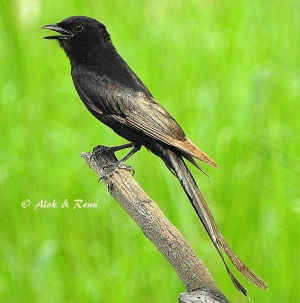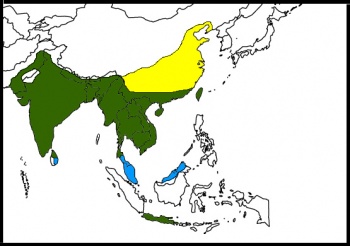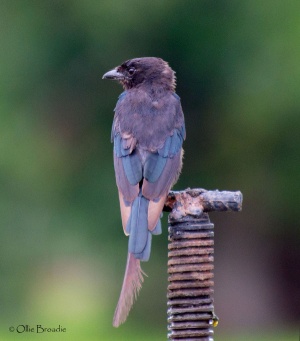Alternative name: King Crow
- Dicrurus macrocercus
Identification
27 - 31cm (10½-12¼ in). A common drongo of south and southeast Asia:
- Entirely semi-glossy black plumage
- Long, deeply forked and well-flared tail
- Small white spot at gape (rictal spot)
- Dull red eyes
Sexes similar, females are slightly smaller. Juveniles are blackish-brown.
Similar species

Photo © by Alok Tewari
Bharatpur Keoladeo National Park, India, July. 2015
Ashy Drongo is smaller and slimmer and has a longer and narrower-splayed tail. It has also brighter red eyes.
The fork-tailed form of Asian Drongo-Cuckoo can be quite similar.
Distribution
|
The Indian subcontinent and China through South-East Asia discontinuously to Java and Bali. | |
| Legend • all year |
Taxonomy
Subspecies
There are 7 subspecies[1]:
- D. m. albirictus in the Himalayas from eastern Afghanistan and Pakistan east to northern Burma and southeast Tibet, south to central India. Wintering in southern India, southern Burma and northern Thailand
- D. m. macrocercus in Peninsular India
- D. m. minor in Sri Lanka
- D. m. cathoecus in China, northern Burma, northern Thailand, Laos, northern Vietnam and Laos. Winters south to peninsular Malaysia and Singapore.
- D. m. thai in southern Burma, southern Thailand, southern Vietnam and probably eastern Cambodia.
- D. m. harterti in Taiwan
- D. m. javanus in Java and Bali
Forms a superspecies with Fork-tailed Drongo and is sometimes considered conspecific.
Habitat
Open country and farmland with scattered trees. Also in villages, parks, gardens and towns.
Behaviour
Gregarious, gathering in small groups. Hawks for insects from open perches, including small trees and telephone wires. Forms communal roosts.
Breeding
A solitary, highly territorial nester. Defends its nest against bigger birds like crows or raptors. The nest is a broad shallow cup, made of twigs, rootlets, fine grass stems and other vegetable matter. It's placed 4 - 7m above the ground in a tree. Lays 2 - 5 eggs.
Diet
Their diet consists of insects, including locusts, grasshoppers, beetles and crickets.
Vocalisation
Singing while perched in an Eucalyptus Tree. Continuous calls of Bar-headed Geese, Ruddy Shelduck and Delicate Prinia are heard in the recording as well.
Audio © by Alok Tewari
Village Bhindawas, Jhajjar, Haryana, India. 7 December 2023.
References
- Clements, J. F., T. S. Schulenberg, M. J. Iliff, D. Roberson, T. A. Fredericks, B. L. Sullivan, and C. L. Wood. 2018. The eBird/Clements checklist of birds of the world: v2018. Downloaded from http://www.birds.cornell.edu/clementschecklist/download/
- Del Hoyo, J, A Elliott, and D Christie, eds. 2009. Handbook of the Birds of the World. Volume 14: Bush-shrikes to Old World Sparrows. Barcelona: Lynx Edicions. ISBN 978-8496553507
- Rasmussen, PC and JC Anderton. 2005. Birds of South Asia: The Ripley Guide. Barcelona: Lynx Edicions. ISBN 978-8487334672
Recommended Citation
- BirdForum Opus contributors. (2025) Black Drongo. In: BirdForum, the forum for wild birds and birding. Retrieved 30 April 2025 from https://www.birdforum.net/opus/Black_Drongo
External Links
GSearch checked for 2020 platform.







